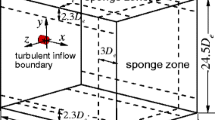Abstract
An integrated hybrid approach for the numerical simulation of aeroacoustics at low Mach numbers is presented. The method is based on a viscous/acoustic splitting. The turbulent incompressible background flow is computed with large eddy simulation, based on the incompressible Navier-Stokes equations, whereas the acoustics are computed from linearized Euler equations with a high-resolution scheme. The focus is on the numerical efficiency of the approach. To accelerate the computations, hierarchical grids and a frozen fluid approach for the acoustics are employed and investigated. For validation and the investigation of the numerical efficiency and accuracy the sound emission of a plate in the turbulent wake of a circular cylinder is employed as a test case.















Similar content being viewed by others
References
FASTEST-Manual (2005) Fachgebiet für Numerische Berechnungsverfahren im Maschinenbau, Technische Universität Darmstadt
Ali I, Becker S, Utzmann J, Munz CD (2008) Aeroacoustic study of a forward facing step using linearized Euler equations. Physica D 237:2184–2189
Ali I, Escobar M, Kaltenbacher M, Becker S (2008) Time domain computation of flow induced sound. Comput Fluids 37:349–359
Bailly C, Juvé D (1999) A stochastic approach to compute subsonic noise unsing Linearized Euler Equations. AIAA Paper 99–1872
Berland J, Lafon P, Crouzet F, Daude F, Bailly C (2010) Numerical Insight into Sound Sources of a Rod-Airfoil Flow Configuration Using Direct Noise Calculation. In: 16th AIAA/CEAS Aeroacoustics Conference
Breuer M (1998) Large Eddy Simulations of the subcritical flow past a circular cylinder: numerical and modeling aspects. Int J Numer Methods Fluids 28:1281–1302
Cabana M, Fortuné V, E L (2010) Direct computation of the sound radiated by shear layers using upwind compact schemes. In: Direct and large-eddy simulation VII, ERCOFTAC Series, vol 13, Springer
Ewert R, Schröder W (2003) Acoustic perturbation equations based on flow decomposition via source filtering. J Comput Phys 188:365–398
Germano M, Piomelli U, Moin P, Cabot W (1991) A dynamic subgrid-scale eddy viscosity model. Phys Fluids A 3(7):1760–1765
Gloerfelt X, Lafon P (2008) Direct computation of the noise induced by a turbulent flow through a diaphragm in a duct at low Mach number. Comput Fluids 37:388–401
Gloerfelt X, Bailly C, Juvé D (2003) Direct computation of the noise radiated bya subsonic cavity flow and application of integral methods. J Sound Vib 266:119–146
Hardin J, Pope D (1994) An acoustic/viscous splitting technique for computational aeroacoustics. Theor Comput Fluid Dyn 6:323–340. doi:10.1007/BF00311844
Jakirlić S, Kadavelil G, Kornhaas M, Schäfer M, Sternel DC, Tropea C (2010) Numerical and physical aspects in LES and hybrid LES/RANS of turbulent flow separation in a 3-D diffuser. Int J Heat Fluid Flow 31:820–832
Kornhaas M (2011) Effiziente numerische Methoden für die Simulation aeroakustischer Probleme mit kleinen Machzahlen. PhD thesis, Technische Universität Darmstadt
Kornhaas M, Sternel DC, Schäfer M (2008) Influence of time step size and convergence criteria on large eddy simulations with implicit time discretization. In: Quality and Reliability of Large-Eddy Simulations, Ercoftac Series 12, Springer, pp 119–130
Kravchenko A, Moin P (2000) Numerical studies of flow over a circular cylinder at \(Re_D=3900\). Phys Fluids 12(2):403–417
Lehnhäuser T, Schäfer M (2002) Improved linear interpolation practice for finite-volume schemes on complex grids. Int J Numer Methods Fluids 38:625–645
Lehnhäuser T, Ertem-Müller S, Schäfer M, Janicka J (2004) Advances in numerical methods for simulating turbulent flows. Prog Comput Fluid Mech 4:208–228
Lighthill M (1952) On sound generated aerodynamically. I. General theorie. Proc Royal Soc London A 211:564–587. doi:10.1098/rspa.1952.0060
Lighthill M (1954) On sound generated aerodynamically. II. Turbulence as a source of sound. Proc Royal Soc London A 222:1–34
Piomelli U, Steett C, Sarkar S (1997) On the computation of sound by large-eddy simulations. J Eng Math 32:217–236
Pope SB (2001) Turbulent flows. Cambridge University Press, Cambridge
Schäfer M (2006) Computational engineering: introduction to numerical methods. Springer, Berlin
Seo JH, Moon YJ (2005) The perturbed compressible equations for aeroacoustic noise prediction at low mach numbers. AIAA J 43(8):1716–1724
Serre E, Minguez M, Pasquetti R, Guilmineau E, Deng G, Kornhaas M, Schäfer M, Fröhlich J, Hinterberger C, Rodi W (2013) On simulating the turbulent flow around the Ahmed body: a French-German collaborative evaluation of LES and DES. Comput Fluids 78:10–23
Shen W, Sørensen J (1999) Aeroacoustic modelling of low-speed flows. Theor Comput Fluid Dyn 13:271–289
Shen W, Sørensen J (1999) Comment on the aeroacoustic formulation of Hardin and Pope. AIAA J 37(1):141–143
Shen W, Michelsen J, Sørensen J (2004) A collocated grid finite volume method for aeroacoustic computations of low-speed flows. J Comput Phys 196:348–366
Smagorinsky J (1963) General circulation experiments with the primitive equations I. The basic experiment. Mon Weather Rev 91(3):99–164
Toro E (1999) Riemann solvers and numerical methods for fluid dynamics, 2nd edn. Springer, Berlin
Wagner CA, Hüttl T, Sagaut P (eds) (2007) Large-eddy simulation for acoustics. Cambridge University Press, Cambridge
Winkler M (2007) Untersuchungen zum vibroakustischen Verhalten von Plattenstrukturen in Wirbelströmungen. Diplomarbeit, Fachhochschule Köln, Institut für Fahrzeugtechnik
Acknowledgments
Thanks are addressed to Frank Kameier from the University of Applied Science Düsseldorf as well as to Klaus Becker and Michael Winkler from the University of Applied Science Köln for the idea to study the cylinder-plate configuration and for providing the corresponding experimental results.
Author information
Authors and Affiliations
Corresponding author
Rights and permissions
About this article
Cite this article
Kornhaas, M., Schäfer, M. & Sternel, D.C. Efficient numerical simulation of aeroacoustics for low Mach number flows interacting with structures. Comput Mech 55, 1143–1154 (2015). https://doi.org/10.1007/s00466-014-1114-1
Received:
Accepted:
Published:
Issue Date:
DOI: https://doi.org/10.1007/s00466-014-1114-1




